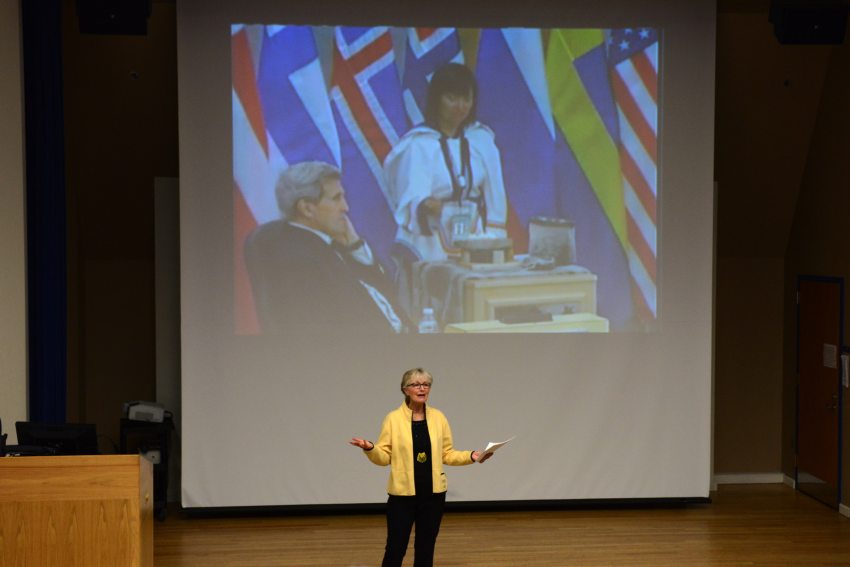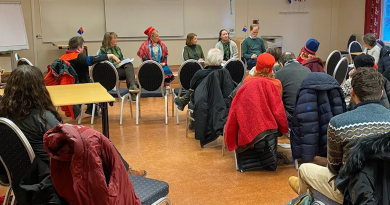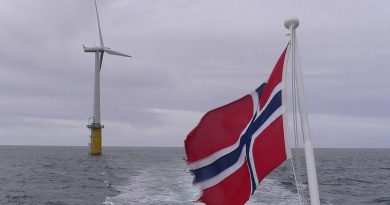The US-led Arctic Council: Still trying to get Americans to care about Arctic

(Erik Hill / Alaska Dispatch News)
When the United States took over chairmanship of the eight-nation Arctic Council a year ago, officials articulated some lofty goals under a theme of “One Arctic.”
The council would promote “Arctic ocean safety, security and stewardship,” improve economic and living conditions in the Arctic and address the impacts of climate change, according to the U.S. plan.
Halfway through the two-year chairmanship, how much of that has been accomplished?
Julie Gourley, the State Department official who represents the nation on the Arctic Council, says the U.S. goals have won support. “There’s a lot of common ground (among) all eight Arctic nations,” Gourley said.
She ticked off some projects already completed or expected to be completed by the time the U.S. chairmanship ends in 2017. A set of safety standards for aerial drones flown for research in the Arctic, the world’s first safety standards for unmanned research aircraft anywhere in the world, is completed. An agreement for collaboration on Arctic science across borders is on its way. Through one of its six working groups, the council is also cataloging all emissions of black carbon — the particulate pollutant that sprinkles soot onto sea ice and harms the health of people breathing it into their lungs — from all eight Arctic nations.
The latter project addresses one of the council’s longstanding concerns, as black carbon is hastening Arctic warming by darkening ice and snow and making them less reflective of solar energy and more susceptible to melt.
“The first step to taking action to mitigate black carbon emissions is to understand where they’re coming from,” Gourley said. “We’re pretty sure that we’re going to have a black-carbon inventory by the end of our chairmanship.”
But anyone expecting the U.S. chairmanship to unleash a torrent of money for megaprojects like an Arctic port or create sweeping policy changes like a ban on offshore Arctic oil drilling is looking in the wrong place.
“It’s important to understand what the Arctic Council is and what it isn’t to understand the accomplishments,” Gourley said.
What is the Arctic Council?
Although governments of all eight nations with Arctic territory are members, the Arctic Council itself is not a government organization. It does not set policy or pass laws. It does not control large amounts of money. It does not undertake projects that benefit only one nation. It holds informational and persuasive powers, but no treaty authority and no ability to impose mandates or engage in enforcement.
Established in 1996, the council is a diplomatic forum for cooperation among governments, research institutions, businesses and nongovernmental bodies — part think tank, part advisory body, part information clearinghouse and part matchmaker, bringing funding organizations together with research and demonstration projects.
It has a permanent secretariat in Tromsø, Norway, that was established in 2013. Member states fund the secretariat’s operations; in the 2015 fiscal year, the U.S. State Department chipped in $125,000.
For much of its 20-year history, the Arctic Council has focused heavily on environmental and science issues, as past work shows. Its mandate specifically excludes military defense and territorial claims.
The council issues many reports, the most famous of which are the 2004 Arctic Climate Impact Assessment, the first comprehensive and independent analysis of climate change in the Arctic, and the 2009 Arctic Marine Shipping Assessment, a planning tool for vessel traffic and service in the far north.
It can be difficult to grasp the distinction between the Arctic Council, which has done fact-finding and information-exchange missions, and the government organizations that are responsible for carrying out policies.
So says Robert Papp, the former U.S. Coast Guard commandant who now serves as the State Department’s special representative for the Arctic. Back when he was leading the Coast Guard and trying to boost U.S. icebreaker capacity, he approached Arctic Council delegations with the mistaken idea that he would get support for such a “parochial” goal.
“What I found out was I really didn’t understand the Arctic Council,” he said at an April 25speech to the Brookings Institution. “What I didn’t realize was this term ‘international forum,’ which is what the Arctic Council is.”
In fact, all Arctic Council action and projects are supposed to be relevant across the entire Arctic, and all require agreement of the eight nations.
Benefits and drawbacks to consensus approach
When consensus is reached across North America, the Nordic nations and Russia — three Arctic regions with vastly different needs and perspectives — that can prompt action from other bodies.
A recent example is the Polar Code, a set of rules for the Arctic and Antarctic regions that the International Maritime Organization approved in 2014 with Arctic Council advice. The IMO, unlike the Arctic Council, can enforce law.
The consensus approach has its drawbacks. It can limit scope of the work, and it can frustrate some advocates.
“What they actually accomplish is what I call the low-hanging fruit,” said Jim Stotts, Alaska president of the Inuit Circumpolar Council, one of the Arctic Council’s six “permanent participants” representing indigenous northern people.
Stotts cited the council’s past work to help governments cooperate on search and rescue missions and oil spill prevention and response as examples of useful but noncontroversial accomplishments.
A more difficult potential Arctic Council project, Stotts said, would be to establish Arctic-wide safety and environmental standards for oil and gas development, which would be followed by binding regulations in each of the eight nations. There is no such project pending at the council, though the concept has been endorsed by the Brookings Institution’s Energy Security Initiative.
Another unachieved goal is council endorsement of a ban on use of heavy fuel oil in the Arctic, a move that conservation organizations have urged. Such a ban, which the Polar Code now imposes for the Antarctic but not the Arctic, would reduce black carbon emissions and the risks of a disastrous oil spill, said Kevin Harun, Arctic program director for the conservation group Pacific Environment. Council endorsement would nudge the IMO to add an Arctic ban to the Polar Code in the future, Harun said.
There is an obvious impediment to such action: Russia relies on cheap heavy fuel oil for its ships and for some of its far-north communities. Harun is optimistic that Russian resistance will eventually fall away.
Tangible benefits to Alaska could result from several council projects that have won consensus, said other Alaska experts.
Many cited a project called ARENA, intended to nurture microgrid renewable energy projects in remote sites. Other projects are focused on suicide prevention, making inventories of Arctic freshwater bodies or assessing the state of telecommunications and of water and sewer systems. One project seeks to spread the Local Environmental Observer network, an Alaska program created by the Alaska Native Tribal Health Consortium, across the circumpolar north.
US challenge: Raise domestic Arctic awareness
Still, there is one parochial aspect to the U.S. chairmanship. Gourley and others involved in U.S. Arctic policy are trying to use the chairmanship to heighten awareness of the Arctic across the nation. “We’ve spent a lot of time on what we call, in the State Department, ‘public diplomacy,’ ” she said.
Gourley said there is evidence of success.
There has been a proliferation of Arctic-related meetings and conferences, not only in Alaska but also in the Lower 48, she said. The State Department has launched a blog called “Our Arctic Nation” intended to highlight Arctic connections to each of the 50 states. The joint U.S.-Canada statement produced at a widely covered March meeting between President Obama and Canadian Prime Minister Justin Trudeau had a heavy Arctic focus.
In Alaska, there are mixed views about whether the U.S. awareness goal is being fulfilled.
Evon Peter, vice chancellor at the University of Alaska Fairbanks, said he believes the chairmanship has helped spread the message.
“I didn’t expect this to be a huge economic boon. But I did expect it to be bringing more attention to Alaska and the Arctic,” he said. “I do think they’ve been able to leverage our chairmanship to bring not only greater U.S. attention but global attention to the Arctic.”
Margaret Williams, Arctic program director of the World Wildlife Fund, said new domestic interest is evident in the list of Alaska-related projects President Obama announced last year and the increased funding for Arctic programs he is seeking from Congress this year, including $400 million for climate-threatened Alaska villages.
Craig Fleener, Gov. Bill Walker’s adviser on Arctic issues, said he is thankful for the “big blowout event” in August when Obama attended the GLACIER conference in Anchorage and toured other parts of Alaska.
Still, Fleener sees signs that Americans are failing to pay attention, possibly because of distractions like the raucous presidential campaign. He cited a recent event he attended in Washington, D.C., where he was disheartened when college students admitted they do not know what is going on in the Arctic.
“We are not doing a very good job of getting the word out,” he said.
Stotts, of the Inuit Circumpolar Council, said it has always been a challenge to get outsiders to think about the Arctic.
“This sounds terrible, but I’ll say it: People in Anchorage don’t even know about the Arctic,” he said.
Related stories from around the North:
Canada: The Arctic Council’s capacity challenge, Blog by Heather Exner-Pirot
Iceland: Iceland blasts Arctic Five for exclusion from fishing agreement, Eye on the Arctic
Norway: Arctic Council aims to boost business, Barents Observer
Sweden: Arctic Council – From looking out to looking in, Blog by Mia Bennett, Cryopolitics
United States: Arctic Council uses Fairbanks meeting to think about the future, Alaska Dispatch News



